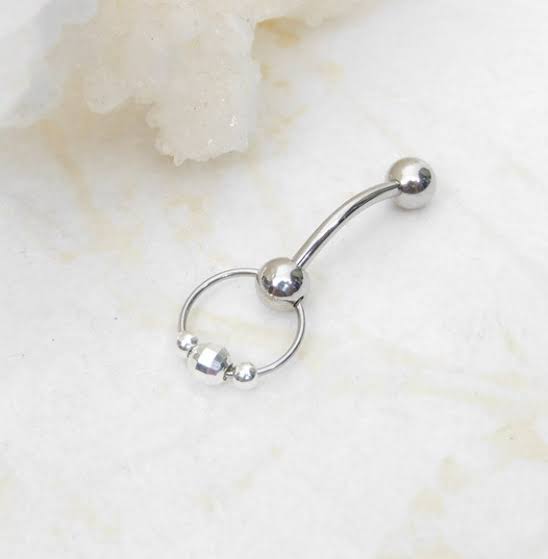A VCH (Vertical Clitoral Hood) piercing is a type of genital piercing that is placed through the vertical hood of the clitoris, a thin layer of skin that covers the clitoral head. It is a popular piercing among individuals seeking to enhance their sexual pleasure or simply to express themselves through body art. While a VCH piercing can be a unique form of self-expression, it’s important to understand the procedure, aftercare, potential risks, and benefits before deciding if it’s the right choice for you.
Table of Contents:
- What is a VCH Piercing?
- How is a VCH Piercing Done?
- Benefits of a VCH Piercing
- Pain and Healing: What to Expect
- Aftercare for a VCH Piercing
- Risks and Complications
- Is a VCH Piercing Right for You?
- Wrapping Up: Final Thoughts
- Frequently Asked Questions
1. What is a VCH Piercing?
A VCH piercing is a genital piercing that involves inserting a small gauge jewelry (often a curved barbell) through the vertical clitoral hood. The clitoral hood is a small piece of skin that covers the clitoris, and the piercing passes through this tissue. Unlike other genital piercings, the VCH is not placed through the clitoris itself, but instead through the hood that covers it.
While the VCH piercing is popular among those who seek increased sexual pleasure or simply want to explore body modification, it’s essential to understand the anatomy involved and the piercing process.
2. How is a VCH Piercing Done?
A VCH piercing is typically done by a professional piercer in a sterile environment. Here’s a brief overview of what to expect during the procedure:
- Consultation: Before getting a VCH piercing, you’ll meet with the piercer to discuss your anatomy, expectations, and the piercing procedure. The piercer will check the anatomy of your clitoral hood to ensure it is suitable for the piercing.
- Marking: The piercer will mark the area where the piercing will be done, so you can see exactly where the needle will go.
- Piercing: The piercer will then use a sterile, hollow needle to create the piercing. The needle is typically inserted through the vertical hood of the clitoris, and jewelry is immediately inserted.
- Jewelry: A curved barbell is the most common type of jewelry used for a VCH piercing, although some may prefer a ring or another style.
The entire process usually takes just a few minutes. While the piercing itself can cause discomfort, the procedure is relatively quick.
3. Benefits of a VCH Piercing
Many individuals opt for a VCH piercing due to the potential benefits, both aesthetic and functional. Here are a few reasons people get this piercing:
- Increased Sexual Pleasure: One of the most commonly reported benefits of a VCH piercing is heightened sexual pleasure. The jewelry may provide additional stimulation to the clitoris and surrounding areas, potentially leading to more intense orgasms or increased sensitivity.
- Body Art Expression: Like many other piercings, a VCH piercing can be an expression of personal style or an addition to one’s collection of body art.
- Aesthetic Appeal: Some individuals find that the VCH piercing enhances the appearance of the genital area, giving it a unique, artistic flair.
4. Pain and Healing: What to Expect
Pain
The pain level associated with a VCH piercing can vary from person to person. Most people describe the pain as brief and sharp, but it subsides quickly once the piercing is complete. The discomfort experienced during the procedure is generally mild compared to other body piercings.
Healing Process
The healing time for a VCH piercing typically ranges from 4 to 6 weeks, but it can take up to 3 to 6 months for full healing. During this time, it’s important to avoid any sexual activity or anything that could introduce bacteria to the piercing site, as it can increase the risk of infection.
5. Aftercare for a VCH Piercing
Proper aftercare is crucial for ensuring that the VCH piercing heals without complications. Here are some tips for aftercare:
- Cleaning: Clean the piercing site with a saline solution (preferably sterile) at least once or twice daily. Avoid using alcohol, hydrogen peroxide, or harsh antiseptics as they can irritate the piercing.
- Avoid Friction: During the healing period, avoid activities that might cause friction, like tight clothing or sexual activity. Wearing loose-fitting underwear and avoiding vigorous physical activity can help speed up healing.
- Avoid Touching: Don’t touch the piercing with dirty hands. Always wash your hands before touching the piercing to avoid introducing bacteria.
- Follow Up: If any swelling, redness, or discomfort persists for more than a few days, or if there is discharge, it’s a good idea to consult with a professional piercer or a doctor for advice.
6. Risks and Complications
While a VCH piercing is generally safe when done by a professional piercer, there are some potential risks and complications to be aware of:
- Infection: Like any piercing, there is a risk of infection. Keeping the piercing clean and following aftercare instructions can help minimize this risk.
- Rejection or Migration: In some cases, the body may push the piercing out over time, especially if the piercing isn’t done properly or if the jewelry is too large for the area.
- Scarring: While rare, excessive scarring or keloid formation can occur if the piercing isn’t properly cared for.
- Increased Sensitivity or Pain: Some people may experience discomfort or increased sensitivity, although this typically improves over time as the piercing heals.
7. Is a VCH Piercing Right for You?
A VCH piercing may be a good choice for individuals who are comfortable with their anatomy and are looking for a form of body modification that can enhance their sexual pleasure or aesthetic appeal. However, it’s not for everyone, and there are a few factors to consider:
- Anatomy: Not everyone’s anatomy is suited for a VCH piercing. Your piercer will assess whether your clitoral hood is appropriate for this type of piercing.
- Comfort Level: A VCH piercing is a genital piercing, so it’s essential to be comfortable with the idea of body modification in sensitive areas.
- Health Considerations: If you have any health conditions or if you are pregnant, you should consult with a healthcare provider before getting a VCHpiercing.
Final Thoughts
A VCHpiercing can be an exciting way to enhance your sexual experience or express your individuality through body art. It’s important to go to a professional piercerCoconut Drink: Support Your Heart Health, Boost Skin Glow who has experience with genital piercings to ensure a safe procedure. Understanding the pain, healing process, aftercare, and potential risks is crucial for a smooth and successful experience.
Whether you’re considering a VCHpiercing for personal pleasure, aesthetics, or both, make sure it’s the right decision for you, and always prioritize safety and hygiene.
You May Also Ask
Q1: How much does a VCHpiercing cost?
The cost of a VCHpiercing can vary depending on the piercer and location, but it typically ranges from $50 to $100, excluding the cost of jewelry.
Q2: Can I remove my VCHpiercing after it heals?
Yes, once healed, you can remove the piercing. However, keep in mind that the piercing hole may close up over time if you decide not to keep the jewelry in.
Q3: Is the VCHpiercing painful?
Most people report the piercing as being brief and sharp but not unbearable. The pain usually subsides quickly after the procedure.
Q4: Can I still have sexual activity after getting a VCHPiercing?
It’s recommended to avoid sexual activity for at least 4 to 6 weeks while the piercing heals to avoid irritation and infection.
If you’re considering this piercing, make sure you’re fully informed and comfortable with your decision, and take good care of your piercing during the healing process.




What i don’t realize is actually how you’re not really much more well-liked than you may be now. You are very intelligent. You realize thus considerably relating to this subject, made me personally consider it from numerous varied angles. Its like men and women aren’t fascinated unless it’s one thing to do with Lady gaga! Your own stuffs nice. Always maintain it up!
I believe you have mentioned some very interesting points, regards for the post.
It’s actually a nice and helpful piece of info. I am happy that you just shared this helpful information with us. Please stay us informed like this. Thank you for sharing.
I conceive this web site has some very wonderful information for everyone. “As we grow oldthe beauty steals inward.” by Ralph Waldo Emerson.
Hi , I do believe this is an excellent blog. I stumbled upon it on Yahoo , i will come back once again. Money and freedom is the best way to change, may you be rich and help other people.
Those are yours alright! . We at least need to get these people stealing images to start blogging! They probably just did a image search and grabbed them. They look good though!
F*ckin¦ amazing things here. I¦m very glad to look your post. Thanks so much and i’m looking ahead to contact you. Will you please drop me a mail?